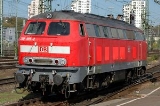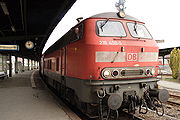
DB V 160 family
Encyclopedia
The DB V 160 locomotive family comprises several classes of closely related 4 axle diesel-hydraulic locomotives built in the 1960s and 1970s for the Deutsche Bundesbahn
which take the moniker from the earliest built model: the 'DB Class V 160'.
The DB Classes V 160 (later 216 and 215), V 162 (later 217), V 164 (later 218), V 169 (later 219) and DB Class 210 comprise the family, being supplemented by the DBAG Classes 225 and 226, formed from original rebuilt machines.
They are formed the backbone of non-shunting locomotive diesel traction in Germany up to the 1990s, and continued to do so along with the Class 232 locomotives of the former Deutsche Reichsbahn
in the 2000s.
, had two engines of 800/980 kW each. That concept proved very expensive in maintenance; therefore, in the mid-1950s, construction began for a medium-duty single engine locomotive.
–1600 hp, V standing for Verbrennungsmotor.
Maximum speed was either 80 or (depending on the setting of the two speed hydraulic transmission). Various lightweight materials and construction methods were employed to keep the weight below 80 t. From 1963 to 1969, two-hundred and fourteen Class 216 locomotives were manufactured. They were used both for passenger and freight service. Heating for passenger coaches was made available by a steam boiler.
.
 After some testing in class 215 units, a stronger engine with 1,840 kW (later increased to 2,060 kW) was approved for rail service. Power for supply of electricity by generator could be taken directly from this more powerful main engine. The result was Class 218, with some 410 units built between 1971 and 1979; these became the backbone of diesel traction at Deutsche Bahn AG. Class 218 locomotives were used for any type of train, from intercity trains to heavy freight trains. Where necessary, double or triple traction was possible. Maximum speed was 140 km/h (100 km/h in low gear) and all locomotives were equipped with a hydraulic braking system.
After some testing in class 215 units, a stronger engine with 1,840 kW (later increased to 2,060 kW) was approved for rail service. Power for supply of electricity by generator could be taken directly from this more powerful main engine. The result was Class 218, with some 410 units built between 1971 and 1979; these became the backbone of diesel traction at Deutsche Bahn AG. Class 218 locomotives were used for any type of train, from intercity trains to heavy freight trains. Where necessary, double or triple traction was possible. Maximum speed was 140 km/h (100 km/h in low gear) and all locomotives were equipped with a hydraulic braking system.
A subclass 218.9 was formed from rebuilt Class 210s, with the auxiliary gas turbine removed.
and the Deutsche Reichsbahn for the East German DR Class 119, no Class V 169s having survived at that point.
as of 2008. It has not been decided yet how to replace the aging class 215 and class 218 units. However, an ever increasing number of passenger trains are being changed from locomotive/passenger coach type to modern DMU units, so the class 218's role in passenger service is decreasing. In freight service, former East German Class 232 units have taken over many trains. Nevertheless, some Class 218 units are refitted and are now numbered as Class 218.8.
Deutsche Bundesbahn
The Deutsche Bundesbahn or DB was formed as the state railway of the newly established Federal Republic of Germany on September 7, 1949 as a successor of the Deutsche Reichsbahn-Gesellschaft '...
which take the moniker from the earliest built model: the 'DB Class V 160'.
The DB Classes V 160 (later 216 and 215), V 162 (later 217), V 164 (later 218), V 169 (later 219) and DB Class 210 comprise the family, being supplemented by the DBAG Classes 225 and 226, formed from original rebuilt machines.
They are formed the backbone of non-shunting locomotive diesel traction in Germany up to the 1990s, and continued to do so along with the Class 232 locomotives of the former Deutsche Reichsbahn
Deutsche Reichsbahn
Deutsche Reichsbahn was the name of the following two companies:* Deutsche Reichsbahn, the German Imperial Railways during the Weimar Republic, the Third Reich and the immediate aftermath...
in the 2000s.
DB locomotives
The first post-WWII diesel heavy-duty locomotives, such as the DB Class V 200DB class V 200
DB Class V 200.0 was one of the first diesel-hydraulic express locomotives of the German Deutsche Bundesbahn and - as Am 4/4 - of the SBB-CFF-FFS in Switzerland.-DB Service:...
, had two engines of 800/980 kW each. That concept proved very expensive in maintenance; therefore, in the mid-1950s, construction began for a medium-duty single engine locomotive.
Class 216: The first V 160
In 1960, the first production run of ten units was manufactured, each with one 1,320 kW engine. The name comes from its engine power in horsepowerHorsepower
Horsepower is the name of several units of measurement of power. The most common definitions equal between 735.5 and 750 watts.Horsepower was originally defined to compare the output of steam engines with the power of draft horses in continuous operation. The unit was widely adopted to measure the...
–1600 hp, V standing for Verbrennungsmotor.
Maximum speed was either 80 or (depending on the setting of the two speed hydraulic transmission). Various lightweight materials and construction methods were employed to keep the weight below 80 t. From 1963 to 1969, two-hundred and fourteen Class 216 locomotives were manufactured. They were used both for passenger and freight service. Heating for passenger coaches was made available by a steam boiler.
Class 215
From the original Class 216, the Class 215 was derived, with an increased speed of 140 kilometre per hour (slow gear for freight trains at 100 km/h). The other parameters were largely unchanged, but the length was increased by 400 mm in order to make a later conversion to Class 218 possible. A total of 150 units of this class were produced. Many transferred to DB Cargo, and now are numbered as DBAG Class 225DBAG Class 225
The DBAG Class 225 are a set of related 4 axle diesel hydraulic locomotives from the DB V 160 family. The series does not represent a new build, but a reclassification and/or rebuilding of 1960s and 70s locomotives of Class 215 and 218 units....
.
Class V 162 (Class 217)
As the heating of passenger cars was changing from steam to electricity, another variant with an additional auxiliary engine for electrical production was produced: the Class 217. Only 15 of these units were produced, the single engined Class 218 had far fewer components and so was built in preference. Maximum speed was 140 kilometre per hour and the power output was 1,320 kW plus auxiliary engine.Class V 164 (Class 218)

A subclass 218.9 was formed from rebuilt Class 210s, with the auxiliary gas turbine removed.
Class V 169 (Class 219)
Derived from Class 216 was one single unit with an additional gas turbine; Class V 169 (later Class 219). The class number 219 was reused after the merger of Deutsche BahnDeutsche Bahn
Deutsche Bahn AG is the German national railway company, a private joint stock company . Headquartered in Berlin, it came into existence in 1994 as the successor to the former state railways of Germany, the Deutsche Bundesbahn of West Germany and the Deutsche Reichsbahn of East Germany...
and the Deutsche Reichsbahn for the East German DR Class 119, no Class V 169s having survived at that point.
Class 210
A faster variation was the Class 210, with a maximum speed of 160 km/h. Similar to a class 218 and developed using the gas turbine experience from the Class V 169; eight Class 210 units were equipped with a gas turbine used as a booster. The gas turbines were not fuel efficient and after two turbine failures all were removed and the Class 210 units were renumbered as Class 218.9.DBAG locomotives
The units inherited from the former Deutsche Bundesbahn continued to be essential to the railways of Germany after the merger of the two railway companies. As part of the restructuring of the Deutsche Bahn, and in response to changing requirements, several new classes and sub-classes were formed in this era.DBAG Class 225
Units transferred to DB Cargo, formed of both rebuilt Class 215s (forming the majority of the class) and Class 218 locomotives (forming the subclass 225.8).DBAG Class 226
These units were converted for towing and shunting operations of passenger stock by the addition of Scharfenberg couplers.Private locomotives
Starting Aaound the early 2000s Deutsche Bahn began to withdraw some of its V 160 family from service, some locomotives were scrapped, others were bought by private rail operators, some used 'as is', others were heavily modified, such as DH 1504.Outlook
Most class 215 and class 216 units are no longer in service, although some were reconstructed and now serve private railway companies. The Class 217 units are still used for freight trains around MühldorfMühldorf
Mühldorf am Inn is a town in Bavaria, Germany, and the capital of the district Mühldorf on the river Inn. It is located at , and had a population of about 17,808 in 2005.-History:...
as of 2008. It has not been decided yet how to replace the aging class 215 and class 218 units. However, an ever increasing number of passenger trains are being changed from locomotive/passenger coach type to modern DMU units, so the class 218's role in passenger service is decreasing. In freight service, former East German Class 232 units have taken over many trains. Nevertheless, some Class 218 units are refitted and are now numbered as Class 218.8.
External links
- Die V 160 The V 160s - detailed technical, and operational history of all the classes v160.de
- Die V160-Familie The V160 family, brief history and technical details, analysis of differences between classes. deutsche-lokomotiven.de
- Die V160 Information on V160, V162, and V169 and later classes. epoch-3.de
- History of German long-distance train traffic from 1920 Details of all classes, including areas of operation up to the reunification of Germany. (English). dbtrains.com

